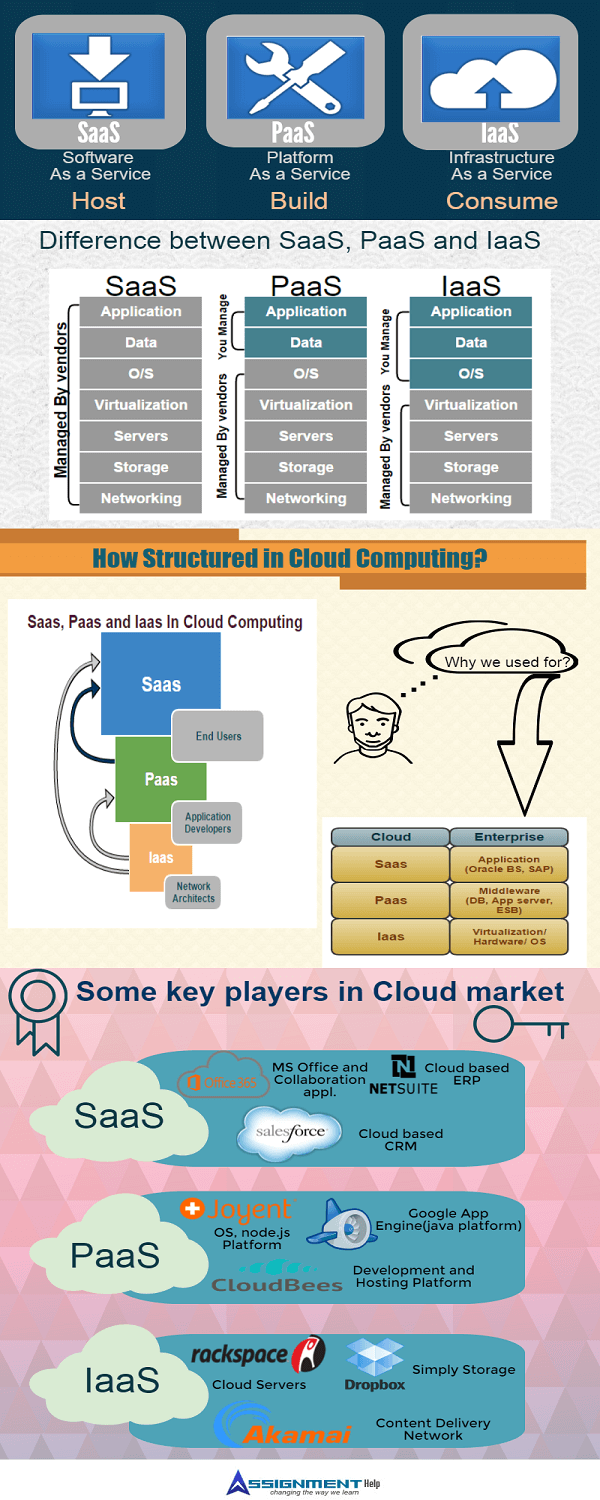Differences between SaaS PaaS IaaS
SaaS-Software as a Service
Saas stands for software as a service which is designed to deliver the application to the end users over the web. This is considered to be a part of cloud computing along with many other parts. This is same as old thin client model, where in saas, client is usually a browser that provide an access to software running on servers. This is one of the most usable service among the other cloud services. This Moves the task by managing software and deploy to the third party services. By using saas application consumer is no going to take care about to buy the software and related to that it also reduce some of the needs like technical staff which were especially hired to manage, install and upgrade software. This will also reduce the cost of licensing software. This is basically like a subscription model where user pay subscription price to use the service.
Examples of Saas
SaaS applications for business are customer relationship management(CRM) applications like Salesforce, productivity software suites like Google Apps, and storage solutions brothers like Box and Dropbox.
PaaS-Platform as a Service
Paas stands for platform as a service which is on the lower level to saas in stack of cloud computing and provide platform where software is to be developed and deployed. Main purpose of paas is to serves an environment which is dealing with the servers, operating systems and system software so that user can concentrate on the application development of their product and service.
Examples of Paas
Examples of PaaS providers include Heroku, Google App Engine, and Red Hat’s OpenShift, joyent for OS and node.js platform, Cloudbees for development and hosting platform.
IaaS-Infrastructure as a Service
Iaas stands for Infrastructure as a Service. While moving down to stack we get this cloud service which incorporate of highly scalable compute resources, complemented by cloud storage and network capability which is self-provisioned, metered and should available on-demand. This is one of the flexible cloud computing model that allow automated deployment of servers, processing power, storage, and networking. How it is different from Paas, Iaas client have true control over service than Pass. The main use of this service is actual development and deployment of Paas and Saas.
Examples of Iaas
There are many providers offering Infrastructure as a Service such as CloudSigma, HPCloud, and Softlayer reach with their own unique value proposition others are akamai as a content delivery manager, Dropbox use for simply storage and rackspace(Clous servers)
Pros and Cons of Saas Paas Iaas
Saas
To implement application in saas is relatively faster. A developer will have a decision authority with minimal IT dependency. Also provide low entry cost and saas application is secure. But if you want to integrate with the other corporate system that may get complicated and also harm you processing application.
Paas
Provide automatic updates of the operating systems and servers instead of user waiting for some time so that he can work on the updated system. Decrease the overall cost it service is utilize by single vendor. Assure compatibility rather all the developers present on the same place or not.
User can be locked to specific environment, language or interface that totally depends on the company providing you paas. This can affect the development if you having need for that specific module in your application. Another Cons of using this service is if you want to grow near future this will might not be possible to grow with this service because this service provide limited scalability.
Iaas
Reduce cost as service implies on the pay-as-you-go model of payment so this is one of the biggest advantage of Iaas. To handle the large variety of demand this service is highly scalable. Provide easier access to employees and business leaders who wants to use business applications. This service make business more flexible and efficient but cut cost and boost productivity.
One of the major concern while using this service is security because vendors are worried about data over the cloud can easily stolen. Another disadvantage is that faced by vendors is network and services crashes this will leave not to access data and systems to vendors.
Embed this Infographics on your site(Copy this Code)
{`
Courtesy of: AssignmentHelpNet
`}




